Last week I had the opportunity to speak with Rohit Nayak, Vice President of Sales, Clinical Information Solutions group at MedPlus. MedPlus is the health information technology subsidiary of Quest Diagnostics and you may already be a bit familiar with the MedPlus name as they have marketed an e-prescribing solution now for a few years. 
I was anxious myself to have the chance to be updated on what is happening with Health IT at Quest for a couple reasons, first being the recent news events on some of the solutions they have provided, and secondly due to my own exposure a number of years ago when I was still writing code and had written a code interchange with Quest in writing my own EMR. It is amazing how far along we have come since my work, which now is in mothballs as technology is way beyond the simple code I wrote years ago when everything was still contained at the doctor’s office and web based applications were far and few between and everyone was afraid to trust them. One comment I have to add though is that the code worked and if I was able to do it, there’s plenty of opportunity for more and a side note here too, Rohit remembers the old Quest interface I worked with so he has quite an extensive background on the development to where they are today.
 Also in the news this week was the announcement of the MedPlus HIE solution going live in New York City from the New York Clinical Information Exchange (NYCLIX).
Also in the news this week was the announcement of the MedPlus HIE solution going live in New York City from the New York Clinical Information Exchange (NYCLIX).
“The New York Clinical Information Exchange (NYCLIX), Inc., consists of 11 hospitals (eight of which are in Manhattan), the Visiting Nurse Service of New York, a federally qualified health center and a faculty practice organization, encompassing about 840,000 emergency room visits, 470,000 discharges, 6.8 million outpatient visits and 5.9 million home visits annually. Incorporated in 2005, the not-for-profit group has received federal and state grants to create its health information exchange.”
First of all Rohit and I began discussing Care360, which was pretty much the first step in Health IT with Quest and has been around for a number of years. For those reading here who are not familiar with Care360, it is a web based solution that gives the physician’s office the ability to enter lab requests electronically and secondary, get the results and this means a lot for consumers as they can go to any Quest Patient Service Center to have their labs done, and you don’t need to worry about losing that slip of paper with the order from the physician as it is paperless.
Rohit stated that the the big focus of their technology today is dedicated to adding value the physician’s office, and to do this it requires building the framework of a patient chart. When lab results are returned, there’s a pretty good chance that treatment of some type may result if they are out of normal tolerances. Quest is the largest lab in the US to provide this service. In addition to entering and receiving lab reports, the system also has the ability to allow physicians to securely communicate with one another, as an example a family practice physician with a specialist. If results come back that would determine the need to follow up with a physician beyond the family practice, and the specialist is “in network” or in other words also a subscriber of Care360, lab results can be forwarded and communication between the 2 physicians is allowed for collaboration.
If a physician is away from the office or medical facility and has an internet connection, no problem, just log on to the Care360 Physician Portal. The use of Care360 eliminates the dependency of having to rely on a fax machine, which sometimes the information is not always clear or having to sit on the phone to wait and get results. Easy for patients too, they can set up a personal account and make and confirm appointments online with Quest Diagnostics and find a listing of insurance coverage by state.
Also as information, Quest has a Patient Assistance program for those who do not have insurance and you can find additional information here and they are green, well we mean besides the color. 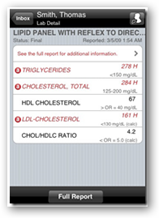
Rohit also discussed the role played by Quest Diagnostics in the dialog and discussions ongoing relative to “Meaningful Use”. There are several objectives here, but number one is probably the most important since we are all patients at some point in time. Over 140,000 physicians,representing about 70,000 practices are currently using Care360 in the US. This is number one on the list relating to “Meaningful Use”:
“Meaningful use “as seen through the patient’s eyes” should specifically inform objectives and measures.”
In addition, Rohit also told me that the Care360 solution connects to other labs across the country as well as radiology vendors and other 3rd party vendors; more on this a bit later. Not too long ago I had a post on the Medical Quack speaking about using an iPhone application from Quest to get patient lab reports. You can read more at the link below. Since April of 2009, the software has been downloaded over 6500 times Rohit stated.
Quest Care360 – Access Patient Lab Results and Medication History from your iPhone
This availability will become even more valuable with Care360 eprescribing, more on this a few paragraphs down.
Next we talked about MedPlus's ChartMaxx solution. Again, for me going backwards in time I remember in the early days when ChartMaxx was pretty much a document manager and the framework for this application has also grown and changed tremendously.
In addition, later this year MedPlus will release the next version of Care360 which will provide capabilities to enable a Physician to create a Electronic version of a patient’s medical record. This EHR offering will also enable physicians to take advantage of economic stimulus incentives available as part of the 2009 American Recovery & Reinvestment Act (ARRA). You can request additional information from the website.
Care 360 integrates with a number of EMR desktop and web software programs as well, some Rohit stated are real time while others are not, and I would perhaps guess too that has a lot to do with the interface written from the EMR software and it’s capabilities. Quest has one common data base for patients for both labs and eprescribing so this eliminates double input with patient demographics.
Next we moved on to discuss prescription history. Labs and medications/prescriptions are compiled together in a single view, and this makes sense as the labs are already in place if the patient has had any diagnostic testing at a Quest facility.
As mentioned above with the lab reports having the ability to be shared, the same can be said for the e-prescribing portion of Care360 too. MedPlus became part of Quest Diagnostics in 2001 Rohit stated and is now the Health IT division of the company. I do remember that myself and have to keep reminding myself. Later this year, prescribing medications/prescriptions will follow the same path as the labs and will be available for integration with personal health records too.
We briefly discussed the free NEPSI e-prescribing plan, of which Quest is a member. Rohit said that yes they have integrated with companies such as Allscripts and Quest was one of the founding members when the association was started to allow physicians a free web based  application to encourage eprescribing.
application to encourage eprescribing.
You can also find eligibility information integrated in the system, depending on who the payers and other potential 3rd parties are in the application.
The next item we discussed was the Centergy Clinical Portal.. This is the connecting product that was mentioned at the top of this page with the connected hospitals and doctors in Manhattan HIE. Rohit stated when you think about all the patients that at some point in time that have had a test done through a Quest Diagnostics center, well that’s a lot of people, and more importantly too a lot of gathered data that is useful to clinicians and hospitals alike. The aggregation software provides a physician centric view with a single sign on so clinicians are not spending a lot of time gaining access, but yet everything is secure. Bringing lab tests and results to the table is a great use of information that exists today through aggregation and saves time and money without having the same tests repeated in some instances and again begins building a framework for a medical record.
He stated that when a patient arrives and the search for information begins with Centergy Clinical Portal, edge servers are being utilized to create an image of all the information available and found on the all connected doctors/hospital systems. The information is brought together and a new record at that facility is created, and the information is seen through a “viewer”. Centergy Clinical Portal is leveraging meta data layers to bring all of this together. The software will bring together the Care360 information along with the information; ChartMaxx data as well as information from other 3rd party HIT vendors. Again, stay tuned for some major changes and application benefits coming later this year.
Now that we have touched on what is available for healthcare professionals, I asked what about the patient, is Quest addressing this part of the solution too? In the recent past I have written about both Google Health and Microsoft HealthVault connections. Rohit took a little additional time here to elaborate on how the PHR (personal health records)work with the Quest system.
Rohit stated the patient needs to be set up with their physician first of all to secure a “pin” number. It is one extra step that is required, but due to privacy and security it is the extra step that is taken to ensure the records are yours. With all the information we hear today about security, it’s really not a problem to go through the motions for this one time set up.
The first step he said is for the consumer to establish an account with Quest Diagnostics and that you can do pretty much like any other type of business online with entering all your information. At the end you will be asked if you want to be able to have your labs (and prescriptions coming later this year) shared with your PHR (personal health record). Quest of course uses a secure connection for this process to protect the data.
The consumer portal for Quest can be found here.
The one nice benefit of having physicians that use e-prescribing is the fact that it all goes to one place by provider. Retailers are also very helpful with their capabilities to share with PHRs, but if you use more than one drug store your information comes from 2 different vendors, with e-prescribing 2 or more doctors, all one share with the PHR and it is linked to the physician so every prescription that goes through the eprescribing process is there.
Rohit again stated the connections and use for the “wired patients” will accelerate and this may also have a positive effect on driving provider/physician participation in the long run.
As you can see from the writing above, this is not only a clinical move but a patient move as well. Myself, I consider the PHR my personal back up for my medical information when needed.
One last item worth a mention too is that Quest Diagnostics is the largest lab in the world and is involved in the testing and participation of clinical trials, to include Pharmacogenomics, in other words working with DNA or genomic based lab tests.
They also offer their web based software Result/View for investigators and others involved in the process.
I want to thank Rohit for taking a few minutes out to go through the offerings and services of Quest Diagnostics and hopefully some of the information gained here will help inform others as to the direction and services they offer and help explain where we are headed with Health IT. In conducting the interview I continued my ongoing education by learning about new and additional services that are available that contribute to the quality of the healthcare we receive today, and Quest Diagnostics is certainly is busy doing their share.
Related Reading:



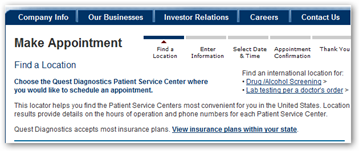


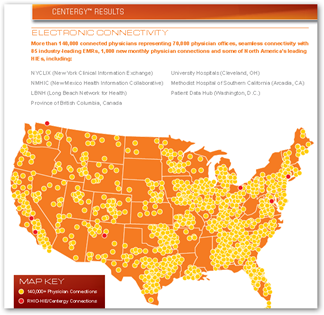
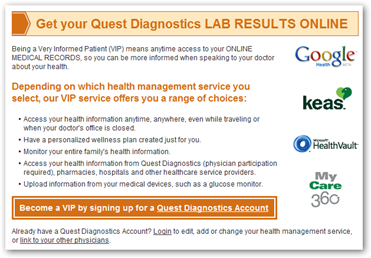
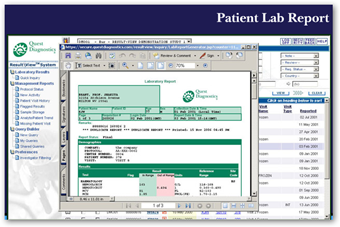

0 comments :
Post a Comment